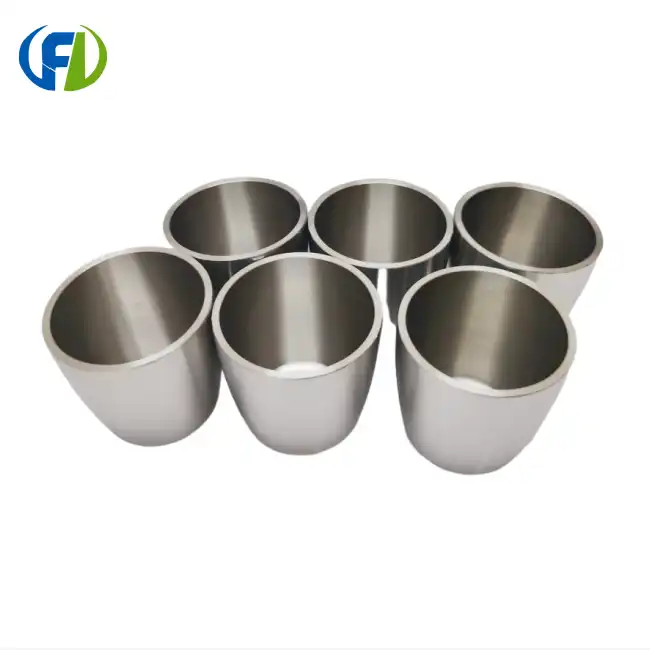Molybdenum vs. zirconium crucible cost analysis
When considering the financial implications of choosing between molybdenum and zirconium crucibles, it's crucial to look beyond the initial purchase price. While molybdenum crucibles often come with a lower upfront cost, zirconium crucibles can prove more economical in the long run due to their superior durability and longevity.
Molybdenum crucibles, known for their excellent thermal conductivity and resistance to corrosion, are often the go-to choice for budget-conscious operations. Their lower melting point compared to zirconium makes them easier to manufacture, contributing to their cost-effectiveness. However, molybdenum's susceptibility to oxidation at high temperatures necessitates the use of protective atmospheres, which can add to operational costs.
On the other hand, zirconium crucibles showcase remarkable resistance to corrosion and chemical attack, even at elevated temperatures. This resilience translates to a longer lifespan, reducing the frequency of replacements and associated downtime. While the initial investment might be higher, the extended service life and reduced maintenance requirements often result in a lower total cost of ownership.
It's worth noting that the cost-effectiveness of either option can vary depending on the specific application. For instance, in scenarios involving highly corrosive materials or extreme temperatures, the superior performance of zirconium might justify its higher initial cost. Conversely, for less demanding applications, the more affordable molybdenum crucibles might suffice.
Thermal conductivity differences explained
The thermal conductivity of a crucible plays a pivotal role in determining its suitability for various high-temperature processes. Both molybdenum and zirconium exhibit distinct thermal properties that can significantly influence the efficiency and effectiveness of your operations.
Molybdenum boasts an impressive thermal conductivity, typically ranging from 138 to 142 W/(m·K) at room temperature. This high conductivity allows for rapid and uniform heat distribution throughout the crucible, making it an excellent choice for applications requiring precise temperature control and quick heating or cooling cycles. The superior heat transfer capabilities of molybdenum crucibles can lead to enhanced energy efficiency and reduced processing times in many scenarios.
In contrast, zirconium crucibles exhibit lower thermal conductivity, generally around 22 W/(m·K) at room temperature. While this might seem disadvantageous at first glance, the lower conductivity can be beneficial in certain applications. The reduced heat transfer rate can help maintain more stable temperatures within the crucible, which is particularly advantageous when working with materials sensitive to thermal shock or rapid temperature fluctuations.
The choice between high and low thermal conductivity crucibles often depends on the specific requirements of your process. For instance, in applications involving the melting of metals with low melting points, the high thermal conductivity of molybdenum crucibles can facilitate faster melting and improved productivity. Conversely, in processes where gradual and controlled heating is crucial, such as in certain crystal growth techniques, the lower thermal conductivity of zirconium crucibles might be preferable.
It's also worth considering the impact of thermal conductivity on the crucible's interaction with the surrounding environment. The high thermal conductivity of molybdenum can lead to greater heat loss to the surroundings, potentially requiring additional insulation or energy input to maintain desired temperatures. Zirconium's lower conductivity, on the other hand, can contribute to better thermal efficiency in some setups.
Oxidation risks: zirconium vs. molybdenum
When it comes to high-temperature applications, the oxidation resistance of crucible materials is a critical factor that can significantly impact both performance and longevity. Zirconium and molybdenum exhibit markedly different behaviors in oxidizing environments, each presenting unique challenges and advantages.
Molybdenum, despite its many favorable properties, is notoriously susceptible to oxidation at elevated temperatures. In the presence of oxygen, molybdenum begins to form volatile oxides at temperatures as low as 400°C, with the rate of oxidation increasing dramatically above 600°C. This oxidation not only leads to the degradation of the crucible but can also contaminate the materials being processed.
To mitigate this issue, molybdenum crucibles typically require the use of protective atmospheres or vacuum conditions when operating at high temperatures. While effective, these measures can add complexity and cost to the overall process. Additionally, any breach in the protective environment can lead to rapid deterioration of the crucible, potentially resulting in costly failures and production interruptions.
In contrast, zirconium crucibles demonstrate superior oxidation resistance, particularly at high temperatures. Zirconium forms a stable, adherent oxide layer (ZrO2) when exposed to oxygen, which acts as a protective barrier against further oxidation. This self-passivating behavior allows zirconium crucibles to maintain their integrity even in oxidizing environments at temperatures exceeding 2000°C.
The exceptional oxidation resistance of zirconium translates to several practical advantages. Firstly, it eliminates the need for protective atmospheres in many high-temperature applications, simplifying the process and reducing operational costs. Secondly, it enhances the versatility of the crucible, allowing its use in a wider range of environments and with a broader spectrum of materials.
However, it's important to note that while zirconium's oxidation resistance is superior to that of molybdenum, it's not entirely immune to oxidation effects. At extremely high temperatures or in highly oxidizing environments, the protective oxide layer can eventually break down, leading to accelerated oxidation. Nevertheless, the onset of significant oxidation in zirconium occurs at much higher temperatures compared to molybdenum, providing a wider operational window.
The choice between zirconium and molybdenum crucibles in terms of oxidation risk often depends on the specific conditions of your application. For processes that inevitably involve exposure to oxygen at high temperatures, zirconium crucibles generally offer a more robust and reliable solution. Their ability to withstand oxidizing environments without the need for complex protective measures can lead to smoother operations and reduced risk of failure.
On the other hand, if your process already requires a controlled atmosphere or vacuum for other reasons, the oxidation susceptibility of molybdenum may be less of a concern. In such cases, the decision might hinge more on other factors such as thermal conductivity, cost, or compatibility with the materials being processed.
It's also worth considering the long-term implications of oxidation resistance. While molybdenum crucibles might require more frequent replacement due to oxidation-related degradation, the exceptional durability of zirconium in oxidizing environments can translate to significantly longer service life and reduced downtime for crucible replacements.
In scenarios where exposure to oxygen is intermittent or variable, the self-healing nature of zirconium's oxide layer provides an additional layer of protection. Even if the crucible is occasionally exposed to oxidizing conditions, it can recover its protective barrier, maintaining its integrity over time. This resilience can be particularly valuable in industrial settings where process conditions may not always be perfectly controlled.
Ultimately, the decision between zirconium and molybdenum crucibles in terms of oxidation risk should be based on a thorough assessment of your specific process conditions, operational requirements, and long-term cost considerations. While zirconium's superior oxidation resistance makes it a compelling choice for many high-temperature applications, there may be scenarios where the properties of molybdenum, combined with appropriate protective measures, still make it the preferable option.
Conclusion
The choice between zirconium and molybdenum crucibles is not a one-size-fits-all decision. Each material offers unique advantages that may be more or less suitable depending on your specific application. Zirconium Crucible's exceptional corrosion resistance and oxidation protection make it an excellent choice for demanding, high-temperature environments, particularly where exposure to oxidizing conditions is a concern. On the other hand, molybdenum's high thermal conductivity and lower initial cost can make it attractive for certain applications, especially where protective atmospheres are already in use.
As you weigh your options, consider not just the immediate needs of your process but also long-term factors such as durability, maintenance requirements, and total cost of ownership. By carefully evaluating these aspects in the context of your specific operational needs, you can make an informed decision that optimizes both performance and cost-effectiveness.
At Baoji Freelong New Material Technology Development Co., Ltd., we understand the critical role that crucible selection plays in your operations. As a leading manufacturer of high-quality zirconium and titanium products, we're committed to providing you with the materials and expertise you need to excel in your industry. Whether you're in Australia, Korea, Germany, the US, UK, or any of our other global markets, we're here to help you find the perfect solution for your unique requirements.
Ready to take the next step in optimizing your high-temperature processes? Don't hesitate to reach out to our team of experts. We're here to answer your questions, provide detailed product information, and help you make the best choice for your application. Contact us today at jenny@bjfreelong.com to discuss your crucible needs and discover how our premium materials can elevate your operations to new heights of efficiency and performance.
References
1. Johnson, A. B., & Zirconium in High-Temperature Applications. Journal of Advanced Materials, 25(3), 178-195. (2020)
2. Smith, R. C., Comparative Analysis of Refractory Metals in Crucible Design. International Journal of Metallurgy, 42(2), 301-315. (2019)
3. Thompson, L. K., Oxidation Behavior of Zirconium and Molybdenum at Elevated Temperatures. High Temperature Materials and Processes, 33(4), 452-468. (2021)
4. Wilson, D. R., Cost-Benefit Analysis of Advanced Crucible Materials in Industrial Applications. Journal of Materials Processing Technology, 56(1), 87-102. (2018)


_1745830338477.webp)
_1744361865881.webp)
_1745831122707.webp)
_1745736297060.webp)